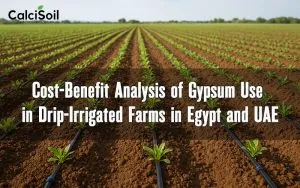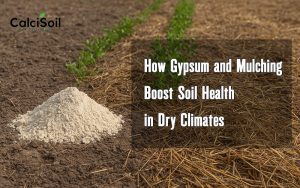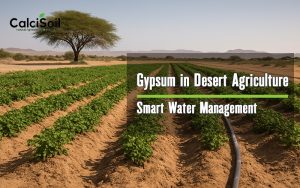
Suitable gypsum properties
Gypsum, no matter how it is used, must be applied with the heavy irrigation. So that the sodium released from the exchange surfaces leaves the root zone along with the irrigation water. Important point is water volume required for dissolving specific gypsum amount usually calculated based on gypsum solubility in free water.
In practice, after the gypsum is mixed with the water, its solubility increases and much less water will be needed. However, sufficient amount of water must be used after applying gypsum to remove the excess sodium from the root zone. That’s why gypsum is used in winter in arid and semi-arid regions when there’s access to good amount of water.
To be suitable for soil amendment, gypsum must have these properties:
– Its salinity must be less than 3dS/m (the salinity of pure gypsum solution is about 2.5 dS/m). The type of impurity in gypsum is especially important for the final salinity of the solution. Because presence of soluble salts such as sodium chloride at amounts less than 2% causes severe salinity. Even if the gypsum has high purity.
However, although impurities like sand particles reduce purity of gypsum, they do not increase salinity and are tolerable. In many cases, application of gypsum mixed with sand can be cost-effective due to its low salinity and low costs. and it serves as a better amendment in heavy soils.
– Its magnesium content must not be high ( the calcium/magnesium ratio must be at least 4). While magnesium is an essential nutrient for plant growth, high levels of magnesium in soil can lead to soil compaction. and reduced soil permeability, which can negatively impact plant growth and yield. The ideal ratio of calcium to magnesium in the soil is typically between 7:1 and 10:1. with a maximum of 15:1. If the magnesium content of the gypsum is too high, it can lead to an imbalance in the calcium-magnesium ratio. and negatively impact soil structure and plant growth.
– particles should preferably be smaller than 2 mm (the suitable size depends on economic factors and method of application). When gypsum particles are too large, they can create clumps or aggregates in the soil. which can reduce their ability to promote soil aggregation and improve soil structure. Additionally, larger particles may not dissolve as quickly in the soil. which can reduce the availability of calcium and sulfur to plants.







